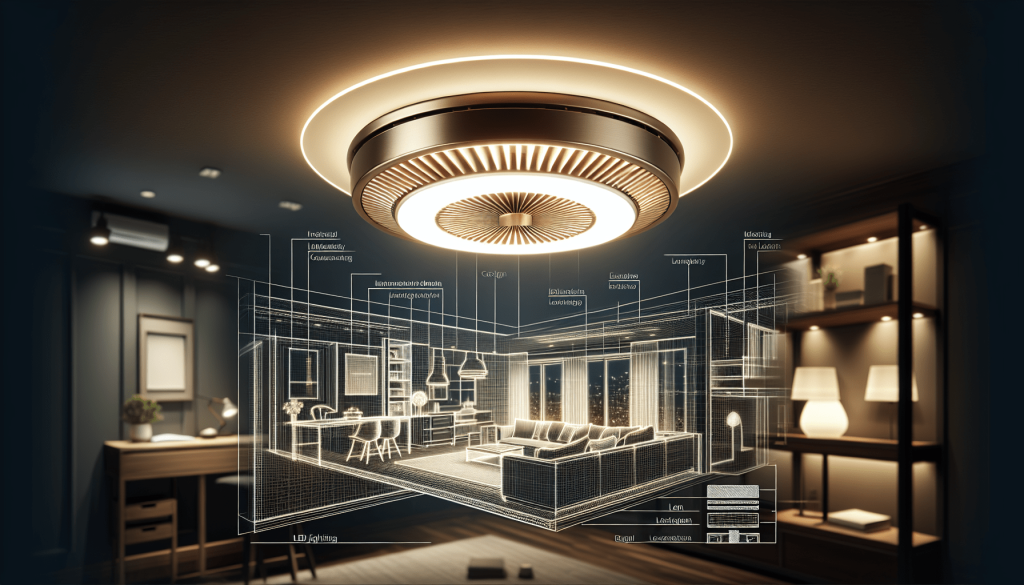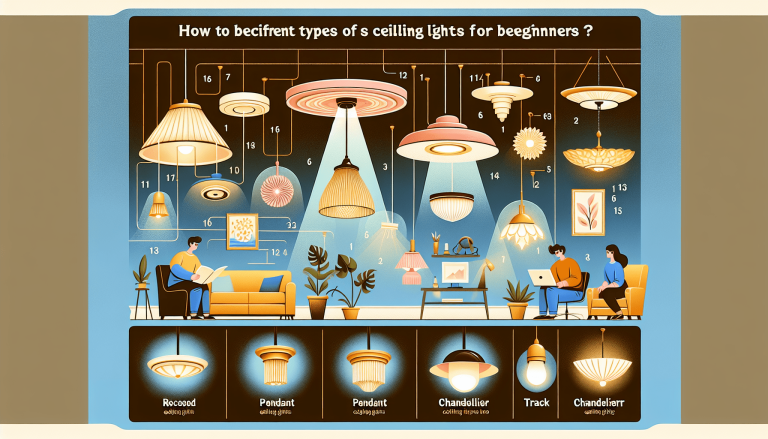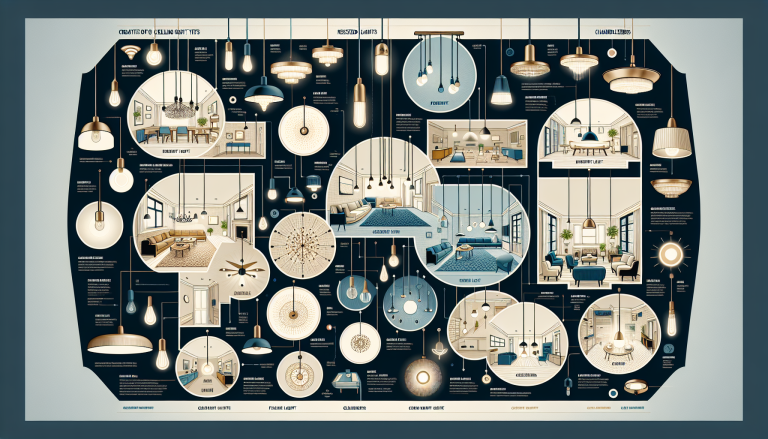Are you looking to switch to LED ceiling lights but feeling overwhelmed by the options available? Don’t worry, we’ve got you covered. In this article, we will provide you with some essential tips that will help you make the right choice when it comes to selecting LED ceiling lights for your home or office. From understanding lumens and wattage to considering the design and functionality, we will guide you through the process of finding the perfect LED ceiling lights to brighten up your space.
Table of Contents
Toggle1. Consider the Lighting Needs
Assess the purpose of the room
When choosing LED ceiling lights, it’s important to consider the purpose of the room. Is it a living room where you’ll entertain guests? A kitchen where you’ll do meal prep? Or a bedroom where you’ll relax and unwind? Understanding the primary function of the room will help determine the type and amount of lighting needed.
Identify the desired lighting effect
Next, think about the desired lighting effect you want to achieve. Do you want bright, energetic lighting for a workspace? Soft and cozy lighting for a bedroom? Or warm and inviting lighting for a living room? Consider the mood you want to create in the room and choose LED ceiling lights that can help you achieve that effect.
Determine the amount of light needed
Lastly, determine the amount of light needed for the room. This will depend on the size of the room and the activities that take place in it. Larger rooms or rooms that require bright lighting, such as kitchens or workspaces, will need higher light output. Smaller rooms or areas meant for relaxation, like bedrooms or reading nooks, may require softer lighting. Consider the lumens rating of the LED lights to ensure they provide the appropriate level of brightness for your needs.
2. Select the Right Color Temperature
Understand the concept of color temperature
Color temperature refers to the warmth or coolness of light. It is measured in Kelvin (K) and can range from warm white (2700K-3000K) to cool white (4000K-5000K). Warmer color temperatures create a cozy and relaxed atmosphere, while cooler color temperatures provide a crisp and energetic feel. Understand the concept of color temperature and how it can impact the mood of a room.
Consider the room’s function and mood
When selecting LED ceiling lights, consider the function and mood of the room. Warm white lights are often preferred in bedrooms and living rooms to create a cozy and welcoming environment. If you’re lighting a workspace or kitchen, cooler white lights may be more suitable to promote concentration and visibility.
Choose the appropriate color temperature for each room
Remember to choose the appropriate color temperature for each room based on its function and desired ambiance. Consider using warmer color temperatures in areas where relaxation and comfort are important, and cooler color temperatures in spaces where clarity and focus are necessary.
3. Evaluate the Light Output
Determine the desired level of brightness
Before selecting LED ceiling lights, determine the desired level of brightness for the room. Consider the activities that will take place in the space and the amount of light needed for those tasks. Brighter lights may be necessary in areas like kitchens or workspaces, while softer lighting may be more appropriate for bedrooms or living rooms.
Check the lumens rating
The lumens rating of LED lights indicates their brightness. Higher lumens mean brighter light output, while lower lumens indicate dimmer lighting. Check the lumens rating of the LED ceiling lights you’re considering and ensure it aligns with your desired level of brightness.
Consider the room size and ceiling height
The size of the room and the height of the ceiling should also be taken into consideration when evaluating the light output. Larger rooms or rooms with higher ceilings may require more powerful LED ceiling lights to adequately illuminate the space. Conversely, smaller rooms or rooms with lower ceilings may not need as much light output.
4. Assess Energy Efficiency
Look for ENERGY STAR certification
When choosing LED ceiling lights, look for ENERGY STAR certification. ENERGY STAR certified lights meet strict energy efficiency guidelines set by the Environmental Protection Agency (EPA). These lights are not only more environmentally friendly but also save you money on energy bills in the long run.
Check the wattage and energy consumption
Check the wattage and energy consumption of the LED lights you’re considering. LED lights are known for their energy efficiency, so opt for lights with lower wattages and energy consumption. This will help reduce your energy usage without compromising on light output.
Consider the lifespan of the LED lights
LED lights have a longer lifespan compared to traditional incandescent or fluorescent lights. Assess the lifespan of the LED lights you’re considering, which is typically measured in hours. Choose lights with longer lifespans to minimize the need for frequent bulb replacements.
5. Consider the Dimming Capability
Decide if dimming functionality is needed
Think about whether you want your LED ceiling lights to have dimming functionality. Dimming lights allows you to adjust the brightness according to your needs and preferences. It can create different atmospheres and enhance the ambience of a room.
Ensure compatibility with existing dimmer switches
If you already have dimmer switches in your home, ensure that the LED lights you choose are compatible with them. Not all LED lights are dimmable, so it’s crucial to check for compatibility before making a purchase.
Choose between analog and digital dimmers
When selecting LED ceiling lights with dimming capability, consider whether you prefer analog or digital dimmers. Analog dimmers use a traditional rotary dial to adjust the brightness, while digital dimmers offer more precision and programmable settings. Choose the type of dimmer that suits your preferences and needs.
6. Evaluate the Beam Angle
Understand the concept of beam angle
Beam angle refers to the spread of light emitted by an LED light source. It is measured in degrees and determines the area illuminated by the light. A narrower beam angle provides a more focused and concentrated light, while a wider beam angle casts light over a larger area.
Consider the room’s layout and size
When evaluating the beam angle of LED ceiling lights, consider the room’s layout and size. Rooms with more corners and obstacles may benefit from wider beam angles to ensure a more even distribution of light. Smaller rooms or areas that require task lighting may benefit from narrower beam angles to enhance visibility.
Choose the appropriate beam angle for each area
Choose the appropriate beam angle for each area based on its lighting needs. Use wider beam angles for general lighting and to illuminate large spaces, while narrower beam angles can be used for accent lighting or to highlight specific areas or objects.
7. Assess the Color Rendering Index (CRI)
Understand the importance of CRI
The Color Rendering Index (CRI) measures how accurately a light source reproduces the colors of objects compared to natural light. It is rated on a scale from 0 to 100, with higher numbers indicating better color rendering. Assessing the CRI is crucial when choosing LED ceiling lights as it affects how colors appear in the room.
Consider the application of the room
Consider the application of the room when evaluating the CRI of LED lights. Rooms where color accuracy is important, such as art studios or dressing areas, may require higher CRI lights to showcase colors accurately. Other areas, like hallways or storage spaces, may not require as high of a CRI rating.
Choose LED ceiling lights with a high CRI
For spaces where color accuracy matters, choose LED ceiling lights with a high CRI rating. Look for lights with a CRI of 80 or above to ensure colors appear vibrant and true to life.
8. Evaluate the Design and Style
Consider the overall interior design
When choosing LED ceiling lights, consider the overall interior design of the room. The lights should complement the existing decor and enhance the aesthetic appeal. Whether your style is modern, traditional, or eclectic, there are LED ceiling lights available in various designs and finishes to suit your taste.
Choose a suitable fixture style
Consider the style of the LED ceiling light fixtures themselves. Do you prefer flush-mount lights that blend seamlessly into the ceiling or pendant lights that make a statement? Whether you opt for sleek and minimalistic designs or decorative fixtures, choose a style that fits your personal preferences and complements the room’s design.
Evaluate the shape, size, and color of the lights
Lastly, evaluate the shape, size, and color of the LED lights. The shape and size should be proportionate to the room and its furnishings. Consider whether you want the lights to be a statement piece or blend in discreetly. Choose a color that complements the room’s color palette and enhances the overall ambiance.
9. Check for Additional Features
Look for adjustable or directional lights
If you want flexibility in directing light, look for LED ceiling lights that are adjustable or directional. These lights can be adjusted or angled to illuminate specific areas or objects, giving you more control over the lighting in the room.
Consider smart lighting options
Smart lighting options can add convenience and customization to your home. Look for LED ceiling lights that are compatible with smart home systems, allowing you to control the lights remotely or automate them according to your preferences. This can enhance energy efficiency and create a more tailored lighting experience.
Check for remote control or app compatibility
If you prefer the convenience of controlling your lights from a distance, check if the LED ceiling lights come with a remote control or are compatible with a lighting app. These features allow you to adjust the brightness, color temperature, or even pre-set lighting scenes without getting up from your seat.
10. Consider the Installation Process
Assess the complexity of installation
Before purchasing LED ceiling lights, assess the complexity of the installation process. Some lights require professional installation, while others can be easily installed as a DIY project. Consider your own skills and comfort level with electrical work. If you’re unsure, it’s best to hire a professional to ensure the installation is done safely and correctly.
Consider professional installation if necessary
If the LED ceiling lights you’ve chosen require professional installation or if you’re not comfortable with electrical work, consider hiring a licensed electrician. They have the knowledge and expertise to install the lights properly, ensuring the safety and functionality of the lighting system.
Ensure the lights are compatible with existing wiring
Lastly, make sure the LED ceiling lights you choose are compatible with your existing wiring. Check the specifications of the lights and compare them to your current electrical setup. If any modifications or rewiring are necessary, consult a professional electrician to ensure it’s done safely and up to code.
By following these essential tips, you can confidently choose LED ceiling lights that meet your lighting needs, suit your style, and enhance the overall ambiance of your space. Consider the purpose of the room, the desired lighting effect, and the amount of light needed. Evaluate factors like color temperature, light output, energy efficiency, dimming capability, beam angle, CRI, design and style, additional features, and the installation process. With careful consideration, you can select LED ceiling lights that will provide optimal lighting and transform your room into a well-lit and inviting space.








